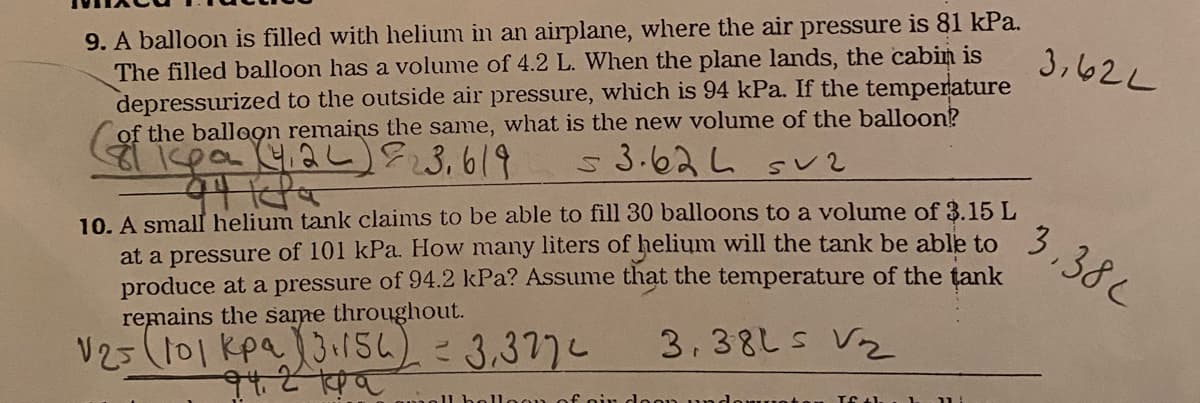I’ve answered the questions already but I’m supposed to have the answer done in significant figures - just need to know if they are done correctly - much appreciated !
I’ve answered the questions already but I’m supposed to have the answer done in significant figures - just need to know if they are done correctly - much appreciated !
Chemistry: Principles and Reactions
8th Edition
ISBN:9781305079373
Author:William L. Masterton, Cecile N. Hurley
Publisher:William L. Masterton, Cecile N. Hurley
Chapter5: Gases
Section: Chapter Questions
Problem 79QAP
Related questions
Question
I’ve answered the questions already but I’m supposed to have the answer done in significant figures - just need to know if they are done correctly - much appreciated !

Transcribed Image Text:9. A balloon is filled with helium in an airplane, where the air pressure is 81 kPa.
The filled balloon has a volume of 4.2 L. When the plane lands, the cabin is
depressurized to the outside air pressure, which is 94 kPa. If the temperature
of the balloọn remains the same, what is the new volume of the balloon?
ispo 42u)3,619
3,62L
s3.62し sく2
10. A small helium tank claims to be able to fill 30 balloons to a volume of 3.15 L
at a pressure of 101 kPa. How many liters of helium will the tank be able to
produce at a pressure of 94.2 kPa? Assume that the temperature of the tank
remains the same throughout.
3.38L
3,38LS V2
V251101Kpa.13154)こ3,377し
11 b
Expert Solution
Step 1
The given problem is based upon gaseous law which can be classified as .,
Boyle's Law at constant temperature.,
PV = Constant
Charles law at constant pressure ,
V/T = Constant
Avogadro's Law at constant temperature and pressure,
V/n= constant
Ideal Gas Law, PV = nRT
here P denotes pressure of gas V denotes Volume occupied by gas T denotes temperature of gas and n denotes number of mole of gas and R denotes Gas constant.
Trending now
This is a popular solution!
Step by step
Solved in 3 steps

Knowledge Booster
Learn more about
Need a deep-dive on the concept behind this application? Look no further. Learn more about this topic, chemistry and related others by exploring similar questions and additional content below.Recommended textbooks for you

Chemistry: Principles and Reactions
Chemistry
ISBN:
9781305079373
Author:
William L. Masterton, Cecile N. Hurley
Publisher:
Cengage Learning

General Chemistry - Standalone book (MindTap Cour…
Chemistry
ISBN:
9781305580343
Author:
Steven D. Gammon, Ebbing, Darrell Ebbing, Steven D., Darrell; Gammon, Darrell Ebbing; Steven D. Gammon, Darrell D.; Gammon, Ebbing; Steven D. Gammon; Darrell
Publisher:
Cengage Learning

Chemistry: The Molecular Science
Chemistry
ISBN:
9781285199047
Author:
John W. Moore, Conrad L. Stanitski
Publisher:
Cengage Learning

Chemistry: Principles and Reactions
Chemistry
ISBN:
9781305079373
Author:
William L. Masterton, Cecile N. Hurley
Publisher:
Cengage Learning

General Chemistry - Standalone book (MindTap Cour…
Chemistry
ISBN:
9781305580343
Author:
Steven D. Gammon, Ebbing, Darrell Ebbing, Steven D., Darrell; Gammon, Darrell Ebbing; Steven D. Gammon, Darrell D.; Gammon, Ebbing; Steven D. Gammon; Darrell
Publisher:
Cengage Learning

Chemistry: The Molecular Science
Chemistry
ISBN:
9781285199047
Author:
John W. Moore, Conrad L. Stanitski
Publisher:
Cengage Learning


Chemistry
Chemistry
ISBN:
9781305957404
Author:
Steven S. Zumdahl, Susan A. Zumdahl, Donald J. DeCoste
Publisher:
Cengage Learning

Chemistry: An Atoms First Approach
Chemistry
ISBN:
9781305079243
Author:
Steven S. Zumdahl, Susan A. Zumdahl
Publisher:
Cengage Learning